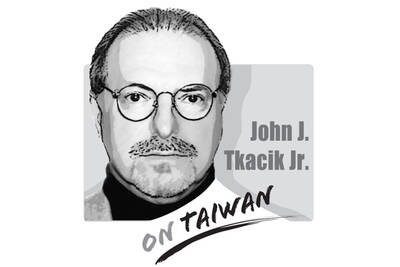Weather is not climate, and a heat wave is not proof of human-induced global warming any more than a snowball disproves it. At the same time, nothing quite focuses the mind on the causes and effects of a hotter planet than nature covering half of the US with a giant pot lid, turning up the burner and letting it boil for a while.
Thanks to a massive heat dome squatting on North America for most of the week, nearly 150 million Americans in 28 states were under some level of heat advisory from the US National Weather Service as of Monday morning. More than 91 million people from Iowa to New York City face the highest level of alert, “extreme heat,” with heat indices in the triple digits, through at least Wednesday.
Of course, there have always been heat waves. Summer is hot, as the climate change deniers in my inbox reliably remind me. However, an increasingly chaotic climate makes heat waves more likely and intense.

Illustration: Mountain People
The heat dome gripping the US this week is partly due to a mundane weather phenomenon — stalled high pressure — but it was made up to five times more likely by the fact that the atmosphere is simply hotter, nonprofit research group Climate Central said. It has only been a year since the “heat blob” that tormented 150 million Americans. Earlier this month, Alaska experienced its first-ever heat advisory.
And if these are the summer scorchers we can expect when the world has only warmed, say, 1.3°C above preindustrial averages, then just imagine what they would be like if and when we reach 3°C of heating, the course we are currently on. Merely hitting 2°C would turn “1000-year” heat waves such as the one that hit the Pacific Northwest four years ago into events that happen once every five to 10 years, the nonprofit research group World Weather Attribution has estimated.
“One of easiest ways to see climate change’s impact is in how it’s increasing the chance these types of heat waves will occur,” Climate Central climate scientist Zachary Labe said. “By the middle of this century, these types of heat waves will be normal. The extremes will be even higher.”
Most alarming to Labe and other scientists is the rise in the number of nights when the temperature fails to cool enough to give overheated human bodies, buildings and infrastructure any relief — a misery many parts of the country will experience firsthand this week. Here again, climate change’s influence is strong. Between 1970 and 2023, average summer minimum temperatures rose by 1.5°C, on average, in 230 US locations studied by Climate Central.
Temperatures that stay so high for so long impose heavy costs on human health and prosperity. Deaths, illnesses and emergency room visits surge.
Nearly 22,000 people died from heat between 1999 and 2023, with the death rate spiking since 2016, reversing years of relative stability, according to a study last year in the journal of the American Medical Association. Heat takes more lives every year than any other weather-related disaster.
And keep in mind official tallies of heat deaths are always undercounting. Heat worsens heart disease and other deadly ailments without leaving traces, meaning it often escapes mention on death certificates.
Extreme heat that lasts all night also strains power supplies as people blast air-conditioners and fans around the clock. The US’ biggest power utility, PJM Interconnection LLC, which serves 65 million people across a swath of the eastern US, has warned this heat wave could push energy demand to its highest levels since at least July 2013. That would keep boosting prices for already expensive electricity. It also increases the risk of brownouts and blackouts, compounding the danger. A heat wave coupled with power failures after Hurricane Beryl last year left Houston-area emergency rooms packed with patients in a grim echo of the early days of the COVID-19 pandemic.
Overheated people, streets, train lines and power grids impose economic costs beyond medical bills and lost lives. Extreme heat gouged US productivity by US$100 billion in 2020, the “purposely conservative” estimate of the Atlantic Council’s Climate Resilience Center showed, a toll expected to rise to US$500 billion per year by 2050.
If we were taking this issue seriously, we would stop burning fossil fuels as quickly as possible, curbing the emissions of greenhouse gases cooking the atmosphere. Meanwhile, we would help states, towns, power suppliers and businesses better prepare for heat waves by planting green spaces, opening cooling centers, hardening infrastructure, conserving energy and checking on vulnerable people to make sure they are safe.
In that fantasy world, the federal government might even declare these events natural disasters, because that is what they are, making dollars available for relief and preparation. Maybe we could even give them memorable names — Heat Wave Exxon, say. We would pump money into climate science to help predict them further in advance, giving us more time to save lives.
In our harsh reality, the climate change deniers running the US government are doing none of the above. In fact, as part of his whole-of-government attack on climate action, US President Donald Trump is doing everything in his power to make heat waves more brutal and costly: The National Oceanic and Atmospheric Administration’s National Heat Strategy, launched just last year to prepare for heat events, has shut down. Most members of an interagency working group on extreme heat have quit. Layoffs at the National Weather Service, Federal Emergency Management Agency, Health and Human Services and other agencies have made emergency response and preparation more difficult. Federal money for local resilience and climate studies is frozen.
And that is just a sampling; a report Monday from the Federation of American Scientists has the whole depressing list of the ways the US is deeply unprepared for this and future heat waves, if you have time and the stomach to read it. Some state and local governments are taking heroic steps to protect their citizens, but stretched budgets only go so far.
As hot as this summer would be, it is also one of the coolest we would ever enjoy again. Just how much hotter and more destructive future summers would become is still in our control.
Mark Gongloff is a Bloomberg Opinion editor and columnist covering climate change. He previously worked for Fortune.com, the Huffington Post and the Wall Street Journal. This column reflects the personal views of the author and does not necessarily reflect the opinion of the editorial board or Bloomberg LP and its owners.
A 50-year-old on Wednesday last week died while under anesthesia at a Taipei cosmetic clinic shortly after undergoing a penis enlargement procedure. The surgeon was arrested for suspected medical malpractice, again bringing to the surface shortcomings in the regulation of cosmetic medicine. Media reports said the clinic owner and surgeon, surnamed Ting (丁), was previously convicted of negligent homicide for a postsurgical death and had been charged with coercion and aggravated assault after allegedly stopping a patient from calling for an ambulance. He had also been fined for failing inspections and had allegedly permitted people without medical licenses to assist

It was most annoying last week to read Chairman Xi Jinping’s (習近平) fulsome encomium to the People’s Liberation Army during the Eightieth Anniversary celebrations of victory over Japan in World War II. Comrade Xi’s soaring rhetoric was stuffed with “martyrs, sacrifice, solemnity and unwavering resolve” in praise of the “Chinese People’s War of Resistance Against Japanese Aggression and the World Anti-Fascist War.” His aspirations overflowed with “world peace” and love of the United Nations, of which China is a founding member. The Liberation Army Daily said that every word from General Secretary Xi Jinping “resounded in his powerful voice, illuminating the
OpenAI CEO Sam Altman recently sat down for an interview with former Fox News host Tucker Carlson in which he openly acknowledged that ChatGPT’s model behavior is indeed influencing the entire world, and that he himself is responsible for the decisions related to the bot’s moral framework. He said that he has not had a good night of sleep since its launch, as the technology could bring about unpredictable consequences. Although the discussion took place in the US, it is closely related to Taiwan. While Altman worries about the concentration of power, the Chinese Communist Party (CCP) has already weaponized artificial
When a Reuters reporter asked Chinese Ministry of Foreign Affairs spokesman Lin Jian (林劍) about Minister of Foreign Affairs Lin Chia-lung’s (林佳龍) European tour, Lin Jian expressed displeasure, referring to Lin Chia-lung as “merely a local foreign affairs official in China,” and reiterating the Chinese Communist Party’s (CCP) oft-used claim that Taiwan is a Chinese “province.” This response is a political falsehood. Although such statements have become standard fare in the CCP’s external messaging, they expose its deepest anxieties. The CCP fears confronting international reality and is even unnerved by the prospect of Taiwan’s subjectivity on the world stage. The CCP